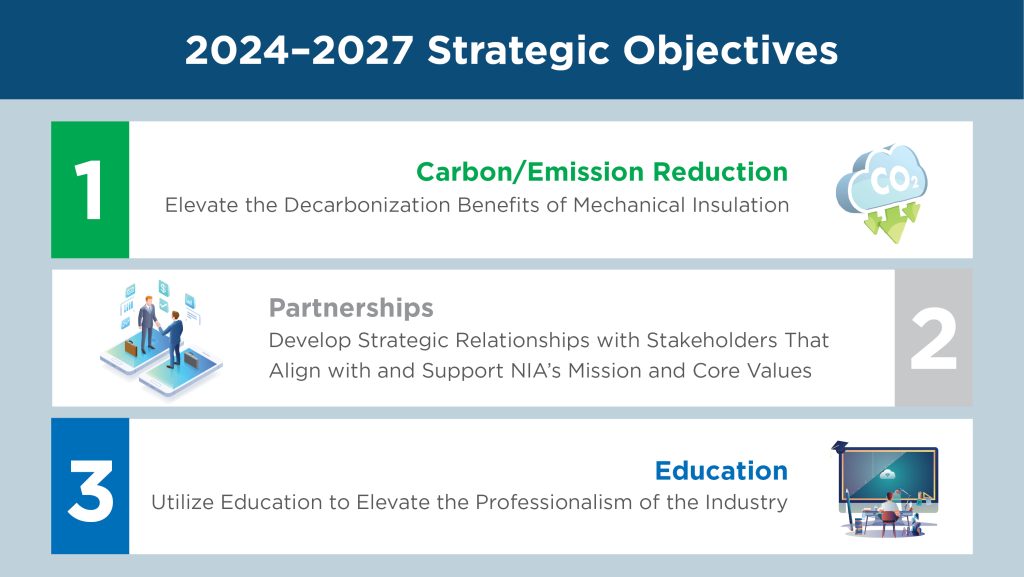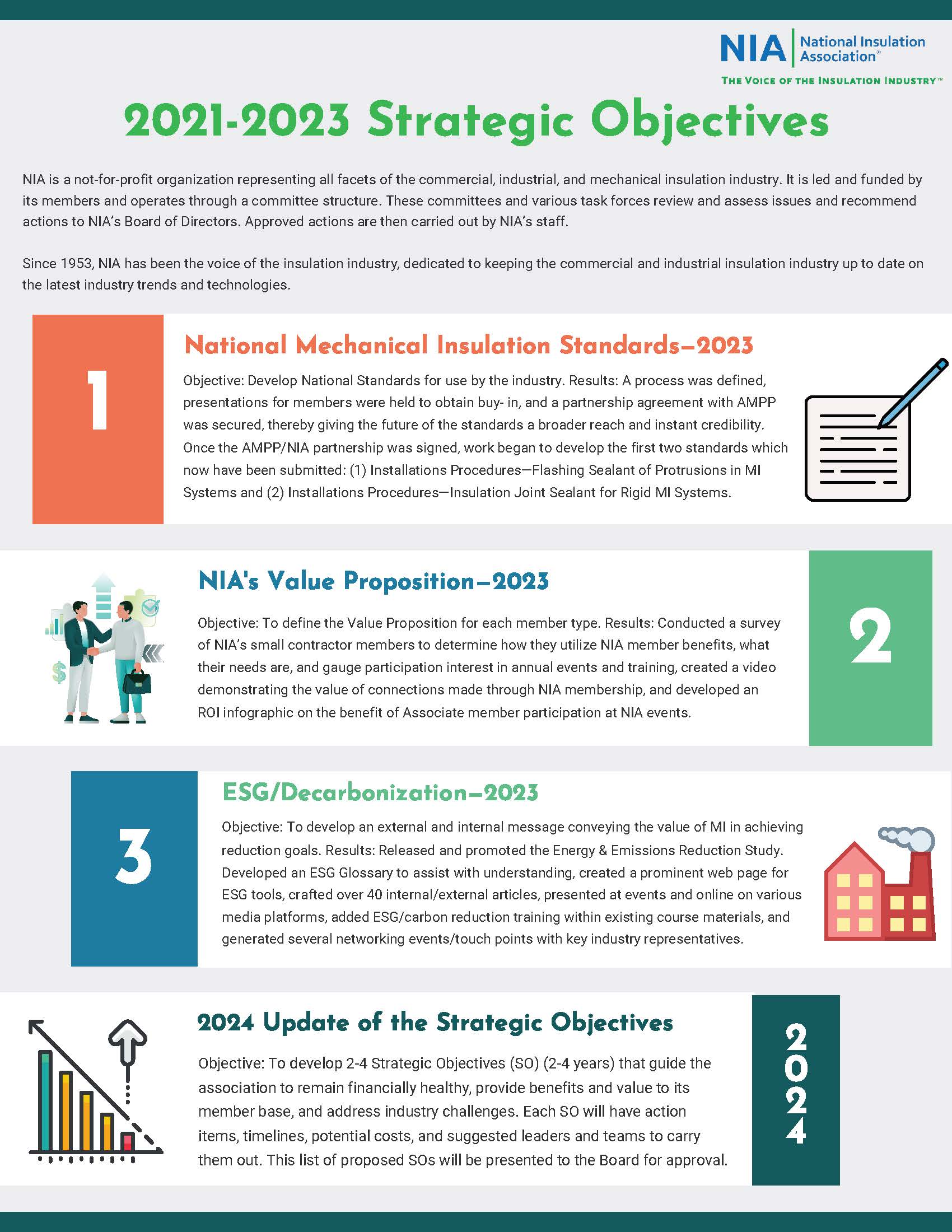NIA's Long Range Planning Committee & Strategic Objectives
NIA is a not-for-profit organization representing all facets of the commercial, industrial, and mechanical insulation industry. It is led and funded by its members and operates through a committee structure. These committees and various task forces review and assess issues and recommend actions to NIA’s Board of Directors. Approved actions are then carried out by NIA’s staff.
Every 3 years during NIA’s July Board of Directors Meeting, the Long-Range Planning (LRP) Committee decides on the priorities for the coming years. The committee develops two to four Strategic Objectives that guide the association to remain financially healthy, provide benefits and value to its member base, and address industry challenges. Each SO will have action items, timelines, potential costs, and suggested leaders and teams to carry them out. The list of proposed SOs will be presented to the Board for approval. The Long Range Strategic Planning Committee is made up of volunteers from the NIA Board and members of the NIA staff.
Key: Strategic Objectives (SO), Tactical Plans (TP), Action Items (AI)

2024–2027
The most recent meeting took place in July 2024, and the LRP Committee developed 3 Strategic Objectives:
- Carbon/Emission Reduction: Elevate the Decarbonization Benefits of Mechanical Insulation
- Partnerships: Develop Strategic Relationships with Stakeholders That Align with and Support NIA's Mission and Core Values
- Education: Utilize Education to Elevate the Professionalism of the Industry
If you are a member of NIA and would like to volunteer to be a part of accomplishing these objectives, or to find out more about how to get involved, email niainfo@insulation.org. In addition, a new NIA Mission Statement was adopted. View it here.
2021–2023
1. National Mechanical Insulation Standards
Objective: Develop National Standards for use by the industry.
Results: A process was defined, presentations for members were held to obtain buy- in, and a partnership agreement with the Association for Materials Protection and Performance (AMPP) was secured, thereby giving the future of the standards a broader reach and instant credibility. Once the AMPP/NIA partnership was signed, work began to develop the first two standards which now have been submitted: (1) Installations Procedures—Flashing Sealant of Protrusions in MI Systems and (2) Installations Procedures—Insulation Joint Sealant for Rigid MI Systems.
2. NIA’s Value Proposition
Objective: To define the Value Proposition for each member type.
Results: Conducted a survey of NIA’s small contractor members to determine how they utilize NIA member benefits, what their needs are, and gauge participation interest in annual events and training, created a video demonstrating the value of connections made through NIA membership, and developed an ROI infographic on the benefit of Associate member participation at NIA events.
3. ESG/Decarbonization
Objective: To develop an external and internal message conveying the value of mechanical insulation (MI) in achieving reduction goals.
Results: Released and promoted the Energy & Emissions Reduction Study. Developed an ESG Glossary to assist with understanding, created a prominent web page for ESG tools, crafted over 40 internal/external articles, presented at events and online on various media platforms, added ESG/carbon reduction training within existing course materials, and generated several networking events/touch points with key industry representatives.

2017–2021
1. Increase Membership
Objectives:
- Determine the size of the potential membership in the current market.
- Determine market value of NIA membership.
- Retain existing members.
Results: With the help of the NIA Membership Committee, successfully reviewed and updated NIA’s potential member database. Used SIC codes to find new potential members. Explored the feasibility and challenges of offering a Professional Membership category aimed at attracting mechanical engineers but found that all benefits were already available for free for them. Analyzed the reasons why members dropped over a 5-year period and restructured the onboarding process for new members.
2. Create Awareness Programs for End Users to Promote Insulation Industry Growth
Objective: Determine what presentations are needed to expand knowledge of common insulation systems.
Results: Three awareness presentations were created.
- Insulation Selection for Power Generation Facilities Video
- Chilled Water and Refrigeration Insulation Systems
- A Guide to Insulation Fastening
- Each presentation is available as a free recorded video and a PowerPoint with speaker’s notes so that any NIA member can use and personalize them for their client meetings or training.
3. Become the Education and Training Leader in our Industry
Objective: Develop the Understanding Mechanical Insulation and Thermal Insulation Inspector Program.
Results: NIA's Thermal Insulation Inspector Certification Program was created and is a 2-part, 4-day course to educate insulation inspectors on how to evaluate installation work and determine whether it is compliant with mechanical insulation specifications.
Objective: Determine member training needs.
Results:
- Created training for members’ career path development.
- NIA now offers six distinct learning programs and educational pathways to fit the needs of industry members at various career levels. Courses are classified as beginning, intermediate, or advanced level.
2015–2017
1. Increase Membership
Objective 1A: Defining the Mechanical Insulation Universe
Results: Determined the universe of mechanical insulation contractors, distributors, manufacturers, laminators, and fabricators and obtain company contact information in order to recruit potential members.
Objective 1B: Develop a Recruitment Plan
Results: Determined a list of potential recruitment and retention methods that could be utilized to promote increased membership and sustained association membership. Note: This tactical was, to varying degrees, dependent upon the outcome of action items in Tactical Plan 1A: Defining the Mechanical Insulation Universe.
2. Improve the Value of Membership
Objective 2A: Conduct a Survey to Determine Needs
Results: Developed a survey that elicited feedback on current member’s satisfaction with NIA benefits and to also provided the opportunity to allow members to provide open feedback.
Objective 2B: Review Existing Services, Benefits, and Programs
Results: Reviewed NIA’s current member benefits, programs, and services and determined if improvements are needed.
Objective 2C: Develop a Leader Program
Results: To address the younger generation entering the mechanical insulation industry and address the need for developing leadership in industry members that will succeed members that are retiring, a new committee was created the Young Professional Advisory Committee. The first YPAC meeting was held March 2017 to serve new workforce members and follow a leadership pathway.
3. Develop Long-Term Funding
Objective: Defining Potential Needs and Develop Funding Mechanisms
Results: Determined the financial needs of NIA, address areas of potential losses, including consolidation, and identified revenue-generating programs with the goal of increasing membership and improving member benefits.
4. Develop a New Website
Objective: Assess the current website and the needs of various audiences that utilize the NIA website and determine a budget and platform upon which to rebuild www.Insulation.org.
Results: The new NIA website was launched in October 2016.
2013–2015
The Long Range Plan focused on the following six objectives for this 3-year period:
- Target End Users and Increase Their Understanding of the Value of Insulation
- Develop a More Precise Picture of Target Audience
- Create a Leadership Development Program
- Younger Member Engagement
- Maintain a Balance of Union/Merit/Distributor/Fabrication Representation on the Board of Directors and Executive Committee
- Succession Planning
2011–2013
The Long Range Plan focused on the following seven strategic objectives for this 3-year period:
- Increase Foundation Contributions from Existing Members
- Increase Funding from Meetings
- Membership Recruitment
- Engage Additional Allied Partners and Re-engage Current Ones
- Develop a Universal Message to the World about the Value of Mechanical Insulation
- Message Development for Global Mechanical Insulation Use
- Marketing Message Deployment
